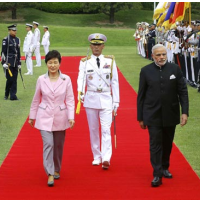Modi Takes Diplomacy to China’s Backyard
 South Korea's president Park Geun-hye (left) and Narendra Modi (right) inspect an honour guard in Seoul (photo: AFP)
South Korea's president Park Geun-hye (left) and Narendra Modi (right) inspect an honour guard in Seoul (photo: AFP)
Prime Minister Narendra Modi used his first visit to China to expand his diplomatic push into China’s own backyard, with visits to Mongolia and South Korea. It was the first time an Indian prime minister had ever visited Mongolia, while in South Korea Modi called for more investment in Indian infrastructure. The prime minister also proposed deepening India’s defence cooperation with both Mongolia and South Korea.
The aim of these visits, according to media reports, is to take the diplomatic tussle between the world’s two most populous countries to China’s own doorstep.
According to the Financial Times, New Delhi bristles at the extension of Beijing’s military and economic influence to the Indian Ocean and to India’s neighbours Pakistan, Sri Lanka, Bangladesh and Nepal.
Modi’s trip to Ulan Bator is being seen as the latest Indian attempt to turn the tables and show that it can play the same games in China’s backyard as China does in India’s.
“The subtle message is for China,” Kanwal Sibal, a former Indian foreign secretary, told Quartz India. “China has been very active in India’s periphery and India is also looking to play on their periphery. India and Mongolia have also had very friendly relations. But Modi will want to convey the message that India has an all-encompassing foreign policy.”
Modi announced that Mongolia was now a “strategic partner”. He said India would help the country’s armed forces with cybersecurity, and also praised Mongolia as the “new bright light of democracy” in the world, a jibe at authoritarian China.
Since the 1990s, resource-rich Mongolia, sandwiched between China and Russia, has been working to expand partnerships with countries beyond its two big neighbours.
Still, India has a lot of ground to cover in Mongolia. After peaking at $60.2 million in 2012, bilateral trade with India fell to $35 million in 2013. China, in comparison, did about $6.2 billion of trade with Mongolia in 2012, and wants to take it to $10 billion by 2020.
Nevertheless, significant opportunities for India remain, as Mongolia has massive reserves of uranium, coal, copper and gold.
India currently has a massive power deficit and Modi’s government has promised to change that through unconventional sources, including nuclear.
The last country that Modi visited on this three-nation tour, South Korea, agreed to upgrade bilateral ties to a ‘Special Strategic Partnership’. Seoul has also offered to provide $10 billion funding for infrastructure projects in India, including smart cities and railways.
“South Korea is part of the same game,” says Brahma Chellaney. “India’s trying to augment its limited power by joining hands with countries around China’s periphery.”
- Karan Singh
To Learn More:
India plays soft power game in China’s backyard (by Victor Mallet, The Financial Times)
India’s Narendra Modi in Mongolia: Wrestling, Buddhism and Democracy (by Shefali Anand, The Wall Street Journal)
Why on earth is Narendra Modi going to Mongolia? (by Many Balachandran, Quartz India)
In South Korea, PM Narendra Modi says now it's time to 'Act East' (Hindustan Times)
'Great Game' For Asia: India's Modi Looks To Korea For Defense Needs After Visiting Arch Rival China (by Donald Kirk, Forbes)
- Top Stories
- Controversies
- Where is the Money Going?
- India and the World
- Appointments and Resignations
- Unusual News
- Latest News
- India College Chain’s Expansion into U.S. Draws Opposition from Massachusetts Officials over Quality of Education
- Milk Shortages in India Tied to Release of New Movies Featuring Nation’s Favorite Stars
- Confusion Swirls around Kashmir Newspaper Ban in Wake of Violent Street Protests
- Polio-Free for 5 Years, India Launches Vaccine Drive after Polio Strain Discovery
- New Aviation Policy Could Increase Service, Lower Ticket Prices






Comments